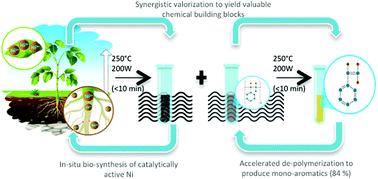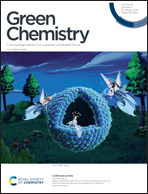Phytocat – a bio-derived Ni catalyst for rapid de-polymerization of polystyrene using a synergistic approach†
Abstract
Environmentally-friendly recycling of polystyrene and disposal of metal-containing plant biomass from phytoremediation sites are major challenges. Strategies beyond waste-to-energy that can harness the circular chemical potential of such feed-stocks are needed. We present a “triple-green” approach using microwave irradiation (250 °C, 200 W, <10 min) for the accelerated de-polymerization of polystyrene and valorization of nickel-contaminated biomass to yield valuable chemical building blocks. Biomass from soil-grown Stackhousia tryonii plants that naturally hyperaccumulate nickel (1.5 wt%), alongside non-hyperaccumulator, hydroponically-grown willow (Salix viminalis, 0.1 wt% Ni) was tested. The presence of naturally-bound nickel in carbonized biomass (Ni-phytocat) from S. tryonii and S. viminalis was shown to significantly accelerate de-polymerization (74% and 69% styrene selectivity; 18 kJ g−1 and 24 kJ g−1 microwave energy consumed, respectively) when compared to control S. viminalis (<0.01 wt% Ni; 56%; 42 kJ g−1) and activated carbon (57%; 36 kJ g−1). The Ni-phytocat offered significant advantage in enabling rapid de-polymerization of polystyrene with up to 91% conversion efficiency as compared to control phytocat (up to 82%) and activated carbon (up to 79%) within 5 min. Use of this synergistic effect of bio-derived Ni and microwaves to maximize the de-polymerization efficiency is proposed.

- This article is part of the themed collection: 2021 Green Chemistry Hot Articles


 Please wait while we load your content...
Please wait while we load your content...